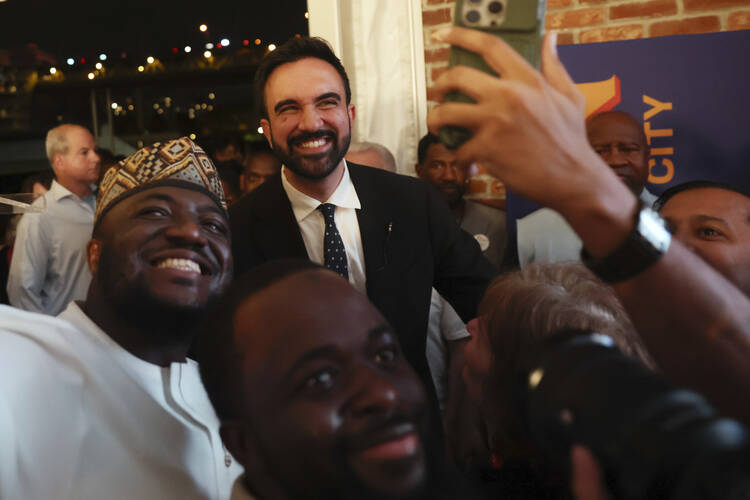On Saturday morning, I was awake, dressed and eating breakfast by 8:30—an occurrence that must have made my parents think the world was ending as they heard me shuffling around the apartment. Armageddon would have to wait a while longer, however, as I was simply preparing for a three-hour shift phone banking for the New York City mayoral candidate Zohran Mamdani.
While it is likely a result of the circles I run in as a College Democrat majoring in government and minoring in justice and peace studies, I haven’t been able to escape Mr. Mamdani’s campaign in the social media theater. He has made my friends and me feel excited and hopeful about politics again after Kamala Harris’s defeat in the 2024 presidential election.
On Tuesday night, Mr. Mamdani pulled off a shocking upset and finished first in the initial round of vote-counting in the Democratic primary for mayor, comfortably ahead of former Gov. Andrew Cuomo. What can his campaign teach the Catholic Church about energizing “Gen Z”? Here are three things.
First, get out into communities. Neighborhood canvassing played a large role in catapulting Mr. Mamdani from 1 percent name recognition to becoming the presumptive Democratic nominee. As of June 4, approximately 30,000 people had knocked on over 750,000 doors for Mr. Mamdani, according to his campaign. In the weeks leading up to the primary election, canvasses all over the city took place every day, from Sunnyside to Bay Ridge to the Upper East Side.
This effort began last December. After the presidential election in November, Mr. Mamdani went to the Jamaica and Fordham neighborhoods of Queens and the Bronx, respectively, to ask working-class people face-to-face why they voted for Donald J. Trump or did not vote at all. Showing up and walking the walk matters. Literally meeting people where they are at matters. If the church wants to attract more young members, then churches should go to them. Be visible presences in their communities and college campuses. Welcome them with open arms, exactly where and as they are.
Second, be cool (even if it means being a little corny). Another component of Mr. Mamdani’s success is his social media presence. He has posted videos in which he talked to New Yorkers outside of Knicks playoff games and discussed his plan for fare-free buses while riding the (already fare-free) Staten Island Ferry. On New Year’s Day, he did a “polar plunge” off Coney Island in a suit to advertise his proposal to freeze the rent for rent-stabilized apartments. He did a virtual town hall with the “Sex and the City” actress Cynthia Nixon (who ran against Mr. Cuomo in the Democratic primary for governor in 2018). He gave “ZetroCards” to canvassers modeled after the MetroCard—and if canvassers completed eight shifts in eight weeks, they could receive a campaign poster. Sure, the earnestness might be a bit much. But it’s authentic, honest and shows that Mr. Mamdani knows what resonates with young voters.
Adapting to social media shows young adults that Catholicism can be “cool.” Consider Father Simon Teller, who uses his Instagram account to make funny but informative videos about Catholicism and the priesthood.
“I have a lot of experiences of people coming up to me and saying, ‘This drew me into the faith and this led me to this event,’ or ‘This made me think about this differently. Hadn’t thought about it before,’” Father Teller, the chaplain and a Dominican friar at Providence College, said in an interview with The Dispatch.
In the 21st century, social media is a force for evangelization. If you build it (a witty and compelling social media presence), they (the youth) will come.
Third, be a people of the people. While there are plenty of debates to be had about the practicalities of Mr. Mamdani’s agenda, it isn’t hard to see why his core message of making living in New York City affordable for everyday people resonated with voters. According to the Office of the New York State Comptroller, food costs in metropolitan New York rose by 56.2 percent between 2012-2013 and 2022-2023 (higher than the national increase of 46.4 percent). In early 2024, the median sales price for a home in New York City was $785,000.
As Gen Z enters adulthood (and a difficult job market), these issues start to affect their lives. This provides an opportunity for the church to portray itself as a church of the common people. Individual churches increasing their community service and social justice outreach programs—soup kitchens, clothing drives, distributing bagged lunches to people experiencing homelessness in the area—could appeal to young progressives wanting to improve their lives and the lives of others in their communities as the cost of living rises.
It may behoove the U.S. church to make Dorothy Day, the co-founder of the Catholic Worker movement, a household (and dorm room) name. If this seems too radical a step, ask yourself who—Pope Leo XIV or Mr. Mamdani—said the following to a group of legislators:
[It is your] responsibility to promote and protect, independent of any special interest, the good of the community, the common good, particularly by defending the vulnerable and the marginalized. This would mean, for example, working to overcome the unacceptable disproportion between the immense wealth concentrated in the hands of a few and the world’s poor.
The Catholic Church shouldn’t be afraid to look to political campaigns for lessons on how to effectively capture the hearts and imaginations of young adults. Our young people are the future—from church to City Hall.








